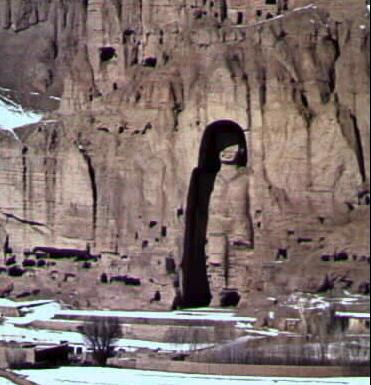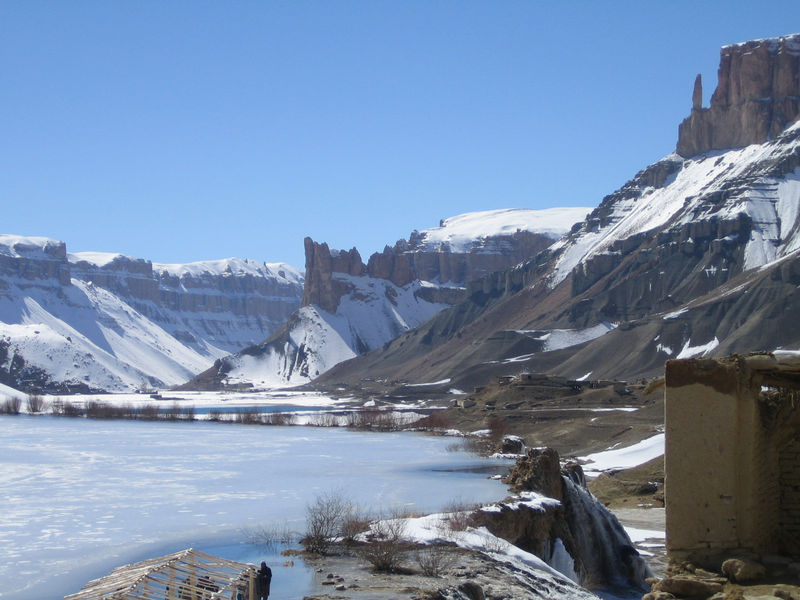Find Out All About Famous Historic Bamiyan
| Bamiyan | |
 | |
| Capital • Coordinates | Bamiyan • |
| Population (2002) • Density | 356,000 • /km² |
| Area | 14,175 km² |
| Time zone | UTC+4:30 |
| Main language | Persian (Dari and Hazaragi dialects) |


Bamiyan is one of the thirty-four provinces of Afghanistan. It is in the centre of the country. Its capital city is also called Bamiyan. Bamiyan city is the largest city in the Hazarajat region of Afghanistan, and is the cultural capital of the Hazara ethnic group that predominates in the area.
Sitting high in the Hazarajat region, the heart of the Hindu Kush, Bamiyan is one of the most beautiful places in Afghanistan. Isolated in modern times, Bamiyan was the centre of the Kushan Empire, one of the greatest periods of Afghan history. Once one on the highlights of the tourism trail in Afghanistan, Bamiyan is now more famous for what it has lost. In April 2001, the Taliban used dynamite and tank fire to destroy the two monumental statues of Buddha carved from the cliffs of the Bamiyan valley over 1500 years before. Now the region is peaceful, hoping that tourists will return.
Where to Stay and Eat
There are several hotels in Bamiyan. Along the main street, the Zohak Hotel is the best, charging around US$20 for a room, or a third of that for a dorm. Cheaper and not as good are Mama Najaf and Marco Polo Hotel. On the hill above the town, facing the cliff are the Bamiyan Hotel, run by the Afghan Tourist Organisation, and the new Roof of the World Hotel. Both have been recently refurbished. It's possible to eat at any of the hotels, although there are several chaikhanas along the main street.
Until recently, Bamiyan's mountain isolation meant that external communications were by satellite phone. A GSM signal for mobile phones can now be picked up from Roshan, and reportedly, internet access is available at the Bamiyan Business Centre on the eastern side of town.
Transport Connections
Minibuses from Bamiyan leave from outside Mama Najaf's Hotel. It takes around seven hours to reach Kabul. There are usually minibuses serving the villages near Band-e Amir for those wishing to visit the lakes. Intrepid travellers may travel from Bamiyan to Herat through the Koh-e Baba Mountains. For more information on this, see the Central Route. There is no direct transport to Mazar-e Sharif; it is quicker to head to Kabul.
Security
Bamiyan is one of the most stable areas in Afghanistan, and security is generally, fully good. There is a Provincial Reconstruction Team from New Zealand based in Bamiyan city.
What to see
Modern Bamiyan is a small town shadowed by the high limestone cliffs that form the boundary of the valley. The most famous of Bamiyan’s landmarks, the colossal Buddha statues have been destroyed, but their remains still dominate the town. Several sights lie close to Bamiyan, not least the fabulous lakes of Band-e Amir.
The Buddhas
The two giant Buddhas of Bamiyan are gone. Since their destruction in March 2001, only the niches in the cliff wall overlooking the Bamiyan valley speak of one of Afghanistan's most remarkable sights.
The two Buddhas, standing at a height of 38 and 53 metres were the greatest product of the rule of the White Huns who ruled the region from the 4th Century AD to the Arab conquest. The giant figures were carved from the cliff, face, with the surface of statues built out with stucco of mud and straw. When completed, the features of the Buddhas were gilded, and the robes painted.
The damage brought on the Buddhas since the Soviet War was not the first injuries to the statues. The Mongol hordes left the statues alone, but the iconoclastic Moghul emperor Aurangzeb had their faces sawed off at the end of the 17th Century, followed by the Persian Nadir Shah who chopped off their legs. During the civil war, the Buddha niches were used as ammunition dumps, and the statues often used for casual target practice by soldiers. The Taliban threatened to destroy the statues on capturing Bamiyan in 1997, but backed down in the face of international pressure, even going as far as declaring that the statues would be a major attraction for tourism when the fighting ceased. This edict was comprehensively reversed in 2001 when Mullah Omar declared the statues un-Islamic and had them destroyed by tank-fire and dynamite, and act that horrified the vast majority of Afghans as well as the outside world.
Although popular with locals, the idea of reconstructing the Buddhas has been rejected by UNESCO, who aim to preserve the site as a monument to Afghanistan's lost cultural heritage. The remaining stones eventually will form part of an open-air museum, and are fenced off.
In the past it was possible the stairs up the niche to view the valley from the top of the large Buddha's head. This may still be possible with a permit from the Office of the Director of Information and Culture at the base of the niche, but should be regarded as very dangerous due to the instability of the rock.
There are around 750 caves along the cliff wall of the Bamiyan valley, once housing monks and decorated with Buddhist frescoes. It is though that around 85% of the paintings have been looted or destroyed. Many of the caves are now home to up to 250 families of internally displaced refugees due to a housing shortage in Bamiyan.
Old Cities
Shahr-e Golgola
The main citadel guarding the Bamiyan valley, 2km east of the town, is totally destroyed and has been lying in ruins since its visitation by Genghis Khan in 1221. The citadel was initially thought impregnable by both its Shansabani defenders and Mongol besiegers. The king's daughter, Leila Khatun betrayed the city in protest of her father's decision to reject her suitor, and revealed to Genghis Kahn the location of an underground spring supplying the defenders. Having dammed the spring and captured the citadel, Genghis Khan executed the princess for deceiving her father. So complete was the subsequent destruction wrought upon the valley, that it gave rise to the name Shahr-e Golgola, 'City of Screams'.
The climb to the top of the ruins affords superb view of the Bamiyan valley. The area around Shahr-e Golgola is mined, and a climb is not recommended without a local guide.
Shahr-e Zohak
Shahr-e Zohak, 'The Red City' is a ruined citadel sitting at the confluence of the Bamiyan and Kalu rivers. It was built by the Shansabani Kings in the 12th Century, although archaeological evidence points to a fort on this site at the time of the White Huns in the 6th Century. During the Mongol invasion, Genghis Khan's favourite grandson was killed during an assault on Shahr-e Zohak, provoking a revenge that left all the inhabitants of the Bamiyan valley dead in his wake.
The ruins sit on a spur of the mountain and can be entered through the citadel's eastern side, up a path punctuated by defensive towers leading to a central courtyard. Barracks off the courtyard could accommodate over two thousand soldiers during a siege. Steps lead up to the ramparts for spectacular views of the surrounding valley and mountains.
Sharh-e Zohak lies 17km east of Bamiyan. A permit may be required to visit the ruins, from the Office of the Director of Information and Culture at the base of the Large Buddha Niche.
Sitting high in the Hazarajat region, the heart of the Hindu Kush, Bamiyan is one of the most beautiful places in Afghanistan. Isolated in modern times, Bamiyan was the centre of the Kushan Empire, one of the greatest periods of Afghan history. Once one on the highlights of the tourism trail in Afghanistan, Bamiyan is now more famous for what it has lost. In April 2001, the Taliban used dynamite and tank fire to destroy the two monumental statues of Buddha carved from the cliffs of the Bamiyan valley over 1500 years before. Now the region is peaceful, hoping that tourists will return.
In antiquity, central Afghanistan was strategically placed to thrive from the Silk Road caravans which criss-crossed the region trading between the Roman Empire, China, Central and South Asia. Bamiyan was a stopping off point for many travellers. It was here where elements of Greek, Persian and Buddhist art were combined into a unique classical style, known as Greco-Buddhist art.
Bamiyan was the site of an early Buddhist monastery. Many statues of Buddha are carved into the sides of cliffs facing Bamiyan city. The two most prominent of these statues were standing Buddhas, now known as the Buddhas of Bamiyan, measuring 55 and 37 meters high respectively, that were the largest examples of standing Buddha carvings in the world. They were probably erected in the 4th or 5th century C.E. They were cultural landmarks for many years and are listed among UNESCO's World Heritage Sites. In March 2001 the Taliban government decreed that the statues were idolatrous and ordered them to be demolished with anti-aircraft artillery and explosives.
Bamiyan is also known for its natural beauty. The Band-e Amir lakes in western Bamiyan province continue to be a tourist destination for Afghans.
- Bamiyan District
- Kahmard
- Panjab
- Sayghan
- Shibar
- Waras
- Yakawlang
Politics
The current governor of the province is Habiba Sarabi, Afghanistan's first female governor. She was appointed in 2005.
The five lakes of Band-e Amir are Afghanistan's greatest natural wonder. They lie at nearly 3000m in the Koh-e Baba range of the Hindu Kush. Each lake is surrounded by a high retaining wall formed by limestone deposits. This unnatural appearance is explained locally by the miraculous intervention of the Caliph Ali, who raised the walls to dam a dangerous river and bring about the conversion to Islam of the local pagan king. The high mineral content of the water means that the lakes change their hue according to the light and time of day, a scene of stunning beauty. Even the best photos really fail to capture the nature of Band-e Amir, with the rich blues easily - but mistakenly - seen as the effects of special camera filters. One of the most amazing sights in Asia, Band-e Amir simply should not be missed. The lakes lie 75km west of Bamiyan, via the village of Shahidan. The road should only be attempted in the summer or autumn due to snow. In good weather the trip from Bamiyan takes around five hours - it is usually necessary to hire a vehicle there as there is little transport to the lakes. An alternative is to take transport to Yawkawlang and get off at the junction to the lakes. From here, it is a couple of hours walk. Take care to stay on the road and not wander freely - the Taliban mined parts of the surrounding area, and the charred remains of one unlucky vehicle can clearly be seen from the road. There is a chaikhana at Band-e Haibat, the lake most people will visit. It sells locally caught fish and will charge an inflated price for a bed for the night. Next to the chaikhana is a small mosque dedicated to Ali, as well as a couple of rowing boats that it's possible to take out on the lake. Swimming is possible for men, but the water is incredibly cold. | |
| |



